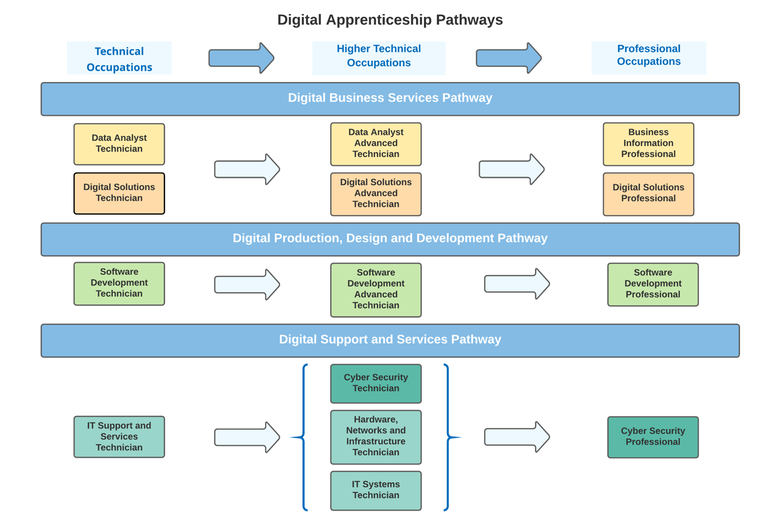Apprenticeship standards - England
Apprenticeship Standards for England are based on occupations recognised by employers and evidenced through job vacancies advertised.
Apprenticeship pathways
Apprenticeship pathways bring these together to show where technical education can lead. They help employers and individuals to understand routes for progression and how occupations at different levels link together

The occupational maps for apprenticeships in England are maintained by the Institute for Apprenticeships and Technical Education.
Apprenticeship Standards
The English is based on an occupational competence model.
All apprenticeship standards in England require the following components:
- 20% formal off-the-job training to provide the required knowledge for the occupation
- Controlled practice in the workplace to demonstrate the development of the required skills and behaviours
- An end-point assessment (EPA)

Earlier apprenticeship frameworks used the completion of a vocational qualification such as an HNC or HND as evidence that the apprentice was employment ready.
Following the Richard Review of Apprenticeships in 2012, the English apprenticeship system was transformed from being qualification based into one based on an occupational competence model.
End-point assessment (EPA)
Apprenticeship standards introduced the concept of an end-point assessment (EPA) to assess occupational competence at the end of a defined period of knowledge acquisition and controlled practice.
- Successful completion of the EPA demonstrates that the apprentice is employment ready.
Every apprentice who completes their apprenticeship standard must undertake a holistic independent end-point Assessment (EPA) to confirm that they have achieved occupational competence.
- The nature of the EPA for each apprenticeship standard is set out in an assessment plan, developed by employers and approved by by the Institute for Apprenticeships and Technical Education (IfATE).
- The EPA is delivered by an independent end-point assessment organisation (EPAO) selected by the employer. Each EPAO is regulated and quality controlled by IfATE.
External Quality Assurance ensures the quality, relevance and reliability of assessment regardless of which organisation delivers it and wherever and whenever that assessment is taken.
- EQA is the independent evaluation that an apprentice has undergone a quality EPA that assesses occupational competence at the end of their apprenticeship.
- It is designed to ensure that apprenticeship EPA is meeting employers’ needs, including consistency and validity of delivery, process and outcomes, as specified in the published apprenticeship standard and assessment plan.
- It is crucial that employers are confident that anyone who has completed an apprenticeship is competent in the occupation for which they have trained.
- The EQA process is fundamental to the credibility of apprenticeships.
- Equally, it is essential that all apprentices have a high-quality experience of EPA, and are confident that the assessment is fair; that they have been assessed to the same standard, whichever EPAO conducts their assessment and wherever and whenever it is taken